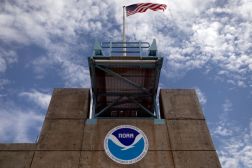NASA, NOAA team up for drone-led hurricane research

A drone like the one pictured will be measuring hurricanes for NOAA. (NASA)
As the country heads into the busiest part of hurricane season, two agencies are teaming up to study the storms in an unprecedented way.
NASA and the National Oceanic and Atmospheric Administration have started sending Global Hawk drones into the atmosphere to study the large storms as they cross the Atlantic Ocean. Sensing Hazards with Operational Unmanned Technology, or SHOUT, will give the National Weather Service a chance to measure and forecast tropical storms in ways manned aircraft simply cannot.
The Global Hawk will cover the Atlantic Ocean basin, collecting data from as high as 60,000 feet, an altitude nearly twice the height a manned aircraft can reach. The drone will drop radiometers and dropsondes into the storms while measuring wind, lightning and precipitation from above. The data will be sent in real-time to forecasters at NOAA’s National Hurricane Center.
The drone “provides us with an observing tool that has the endurance of a satellite but provides finer resolution data and precision of an aircraft,” said Gary Wick, NOAA’s lead scientist for the mission.
NOAA will also be testing if the data can be used if other weather satellites fail.
“We’re hopeful that won’t occur, but we need to evaluate all options,” Wick said.
SHOUT is an offshoot of NASA’s Hurricane and Severe Storm Sentinel, or HS3, program, a five-year mission examining the Saharan Air Layer, which some researchers believe has a hand in the formation of storms in the Atlantic Ocean.
The SHOUT program will send drones into any active storms from now until the end of September.






